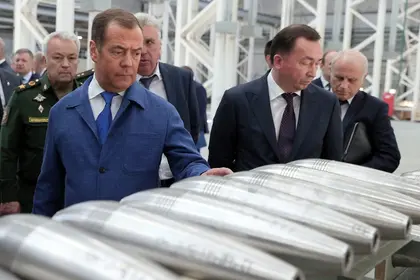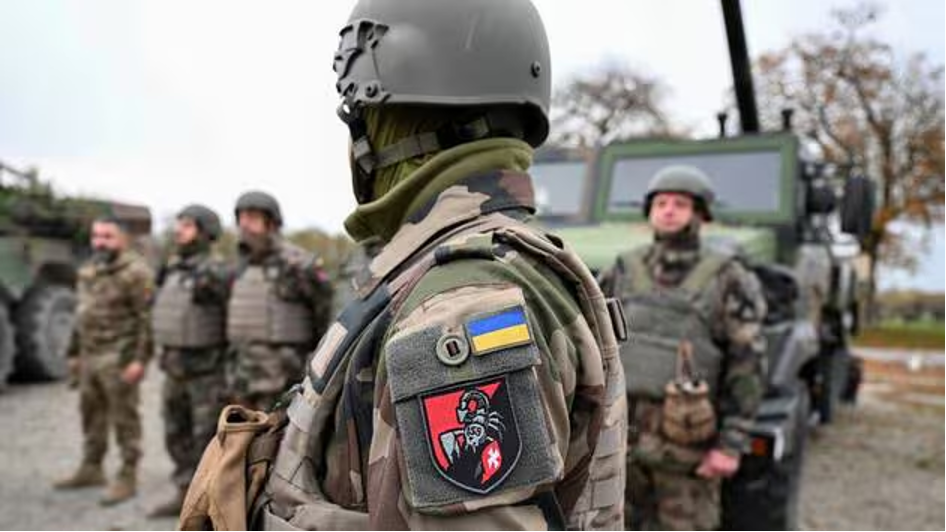Kremlin claims a Ukrainian long-range weapon was responsible for a lethal explosion hitting an apartment building in Belgorod appear to lack substantial evidence to back it up, and chances are much higher it was a Russian weapon that did the damage, Kyiv Post fact checks into the Sunday incident found.
The governor of Russia’s Belgorod Oblast, Governor Vyacheslav Gladkov told local reporters that a Ukrainian projectile struck a 10-story building in the Kharkovskaya Gora district of Belgorod city.
JOIN US ON TELEGRAM
Follow our coverage of the war on the @Kyivpost_official.
Rescue workers and civilians look at a collapsed section of an apartment building in Belgorod, Russia, in a May 12 image published by Ukraine’s Channel 5 television. Official Russian sources claimed a Ukrainian missile caused the damage and killed at least seven residents.
Seventeen people in the building, two of them children, died when a section of the apartment block collapsed into rubble, but a search was still in progress to find possible survivors, a statement from Russia's Emergency Situations Ministry said. Two of the dead, reportedly, were children.
Official Kremlin information platforms blamed a “damaged” Ukrainian Tochka-U surface-to-surface missile was hit by Russian air defenses and knocked out of its probable intended flight path, to smash into the building and explode, dropping between 10 and 20 apartments with people inside, in on themselves.

North Korea Slams US Criticism Over Troops in Ukraine, Calls It ‘Reckless Provocation’
Vladimir Gladkov (second from left, dark jacket) Governor of Russia’s western Belgorod Oblast, gestures at warm drinks provided by emergency response workers to victims of an explosion hitting an apartment building on May 12. Gladkov later claimed the blast killing seven civilians was carried out by the Ukrainian military, but he offered no evidence to support the allegation. Kyiv Post screen grab from the Russian state-run information outlet RIA Novosti.
Russia’s Defense Ministry on Sunday claimed its air defense units operating in Belgorod Oblast on Sunday shot down six Tochku-Us, a hulking missile carrying a 480 kg explosive warhead. Both Russia and Ukraine use the Soviet-designed weapon identified by NATO as SS-21 “Scarab.”
Dozens of videos from the apartment courtyard including one showing the actual explosion, satellite and map images, and comments by independent analysts reviewed by Kyiv Post, cast, at minimum, serious doubt on the Russian claims of Ukrainian fault, and by many measures disprove them.
One of the most compelling material contradictions to the Kremlin narrative of Ukrainian responsibility for the strike was a security cam video showing an explosion erupting from the bottom or first floor of the apartment block and hurling smoke, fire and debris into the courtyard.
Satellite image of the Belgorod apartment building damaged on May 12 and probable direction of incoming munition, per an analysis by the German military information outlet Tendar. The strike is shown to arrive from the northeast. According to that analysis, the weapon most likely responsible for the blast was an errant Russian glide bomb.
The direction of the blast as shown in the video geo-located to the apartment’s location at 50°33'26.27"N, 36°34'44.56"E is from north-east to south-west, in the opposite direction of the likely flight path of a Ukrainian munition fired at Belgorod.
The Tochka-U is a ballistic missile flying in a high, arcing trajectory scraping the edge of space before returning to Earth steeply at multiple Mach speeds.
Models operated by Ukraine are commonly rated to have ranges of between 70-120 km, more than sufficient to hit Belgorod city. But the direction of the explosion shown in the video, and damage caused to buildings and structures around it, is side-to-side, is lateral, opposite of the typical direction of a ballistic missile coming down on its target vertically.
Typically, in the Russo-Ukrainian War, even a damaged Tochka-U with a warhead weighing nearly a half-ton, create a massive crater wherever it strikes. Dozens of video, including recordings by Russian official “news” platforms like TASS and RIA Novosti, show substantial damage at the site of the blast, but no crater common to the detonation of a half-ton missile warhead hitting the ground.
Kyiv Post screen grab from security camera video showing the moment of an explosion hitting an apartment building in Belgorod Russia on May 12. The video shows the direction of the explosion to be from left to right in the image, roughly, moving from northeast towards southwest. The blast appears to initiate in the lower stories of one of the apartment building sections. Some Russian officials claimed a Ukrainian missile was responsible, however, typically, missiles strike upper floors or roofs of buildings and hit vertically not horizontally.
Local social media in the 24 hours following the explosion offered no images or accounts of debris – most often missile fins or engine fragments – commonly left on strike sites following a Tochka-U hit.
Some Russian non-government media, in contrast, published images of debris from what appeared to be pieces of a Russian S-300 anti-aircraft missile purportedly found at the site of the explosion.
The most detailed video of purported S-300 debris was published by the online newspaper Mash. Kyiv Post researchers concluded the debris looked authentic but it wasn’t possible to link, definitively, the debris with the strike site.
Some buildings adjacent to the explosion showed walls peppered with gouges and holes similar to damage caused by the detonation of a warhead designed to scatter metal fragments. The anti-aircraft warhead of an S-300 missile, loaded with an estimated 500 metal cubes each weighing about 50 grams, is capable of having caused the scoring damage, Kyiv Post researchers concluded.
Kyiv Post screen grab of “news” video published by the Russian military information outlet War Gonzo, a/k/a Simon Pegov, of a May 11 Ukrainian missile strike against a restaurant reportedly hosting a holiday party for Russian officers in the Kremlin-occupied city Donetsk. Both Russian and Ukrainian sources said the weapon used was a long-range precision-guided missile, most likely launched by a US-made HIMARS or M270 rocket artillery system. The image shows the powerful blast of a high-trajectory weapon striking the building’s roof and upper floors. Reportedly, four Russian officers and six restaurant workers died in the strike.
Independent analysts reviewing evidence available in open sources consistently ruled out the possibility a Ukrainian missile was responsible for the strike, and suggested a Russian weapon of some form almost certainly caused the damage. Some were not sure whether it was a Russian anti-aircraft missile falling to earth or a Russian aerial bomb dropped by accident.
“In that case, (of a missile hitting the building) the missile must have come from the northeastern direction. A munition of the type FAB-250 / FAB-500 launched from a Russian plane (also) has enough explosive yield to cause such destruction. Again, what can be ruled out is a missile coming from south/southwest, in other words from Ukraine,” the German military information platform Tendar concluded.
⚡️ The moment of hitting on an apartment building in the Russian city of Belgorod pic.twitter.com/SRtfaAedNb
— NEXTA (@nexta_tv) May 12, 2024
Baku-based military commentator Aqil Rustamadze was more definitive, stating on May 12: “Judging by such factors as the strength and location of the explosion, as well as the distance of the object from the border with Ukraine, it is possible to say with a high degree of probability that the high-rise building in Belgorod was hit by a BETAB-500 aerial bomb dropped from a Russian plane. There are more than 20 cases during Russia’s invasion of Ukraine) of accidental drops of Russian aviation bombs.”
Social media image from poster linked to Belgorod region placed on the platform X on May 12. The Ukrainian poster Pavlo A. argues against Kyiv’s responsibility for the damage, pointing to severe damage to the building on its northeastern side, and relatively light (“windows are intact”) damage to its southwestern side. The post concludes “This means this strike was carried out by Russian troops!”
Accidental bomb drops by Russian combat pilots operating in air space over Belgorod have been commonplace for months. From March-May the Russian Air Force accidentally released 32 bombs somewhere in the country, and on May 10 alone, four hit separate rural locations around Belgorod. Those bombs were apparently not armed and did not explode, the independent Astra news and information platform reported.
Image of damage to a wall adjacent to the apartment block that was hit by a powerful explosion in Belgorod on May 12. The scoring and punctures on the lower section of the building facade in the image are typical of damage left by dense metal fragments. Anti-aircraft missiles commonly use metal shrapnel to damage their targets, as do bombs with anti-personnel munitions loaded into them, so either weapon might have caused the damage shown in the image, but that is not conclusive. Kyiv Post screen grab of video published on May 12 by the pro-Russia Readovka information platform.
Technically, a Ukrainian Air Force MiG-29 attack fighter or Su-24 bomber, both of which have been confirmed to have dropped NATO-standard glider bombs in the past, could have hit the apartment building. However, Kyiv Post researchers ruled that possibility out due to the dense Russian air defense network around Belgorod and Armed Forces of Ukraine (AFU) extreme reticence to risk combat aircraft in strikes deep behind Russian lines.
Allegedly, an S-300 anti-aircraft missile fragment found at the site of the apartment blast in Belgorod on May 12. Screen grab from video published by the online Russian newspaper Mash.
The AFU also is known to operate the US-made ATACMs missiles and M30-series guided rockets, both fired by the M270 and HIMARS launch systems, and both are capable of hitting a target in Belgorod from a safe firing site in Ukraine-controlled territory.
But the location and direction of the explosion shown in the video appear dissimilar to both those weapons’ normal battlefield performance, Kyiv Post researchers found. Furthermore, official Russian sources made no claims that a US-made weapon was responsible for the Belgorod explosion.
Ukrainian ground forces have shelled and rocketed targets around Belgorod intermittently since February. The weapons used – artillery rockets and long-range howitzer shells – by most accounts pack insufficient explosives to take down an apartment building section, the Russian milblogger Yan Matveev said.
Kyiv Post screen grab with graphics, showing a probable rocket-assisted glider bomb strike against a Russian position in late March. The unconfirmed video reportedly was recorded by a Russian soldier deployed to the eastern Avdiivka sector. The pro-Russia milblogger Kirill Federov republished it. Although dropped from high in the air, the flight path of the bomb appears to have flown the projectile into the side of the targeted building.
“The simplest and most logical explanation, is that a Russian aerial bomb with glide kit did it. The images look like the explosion of a powerful high explosive munition weighing 500 kg., and bombs like that have been dropped by the Russian Air Force regularly. And even on Belgorod,” Matveev’s analysis said in part.
There was no immediate official Kyiv response to the Russian claims.
You can also highlight the text and press Ctrl + Enter


















